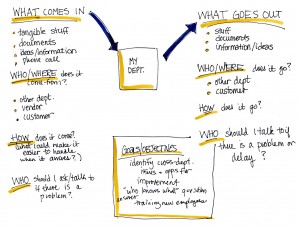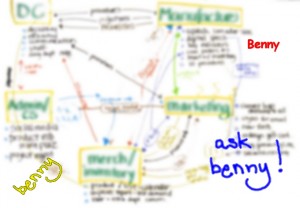In my last post, I began to answer the question “What happens with all those charts after the meeting?” Some specific examples will help you visualize how the use of graphics has helped other organizations do their work better. (Names are fictitious and images edited to protect the privacy of my clients.)
TIE ONE ON: IMPROVING WORKFLOWS
I facilitated an all-day retreat for the staff of Tie One On, a mail order company selling ties and other men’s accessories. I used a combination of pre-drawn charts and in-the-moment scribing throughout the day. Before the meeting, I prepared three illustrated charts: the company’s mission statement; accomplishments from the previous year; and goals for the next year. As we discussed strategies for implementing those goals, we mapped out work flows in order to find areas for improvement.

Each department was asked to fill out this template, noting all the documents, information, and physical items that come into their department and those that leave. For each one, they detailed where they came from or went (other department, customers, vendors, etc.), who was ultimately responsible for each transaction, and anything important that might help make each type of transaction flow more smoothly.

I combined all these maps up on the wall so everyone could see all the intersections. Immediately, staff began to point out places where there were holes, redundancies, or confusion. For example, to the question “Who do you ask if you have questions about this? Who’s ultimately responsible?” almost every map defaulted to “Ask Benny.” No wonder Benny felt overworked and constantly interrupted! We went through the map and clarified the situations where other managers could and should make decisions, leaving Benny free to focus on his core tasks.
Sharing information across departments in this manner helped employees understand how each of their tasks affected every other part of the company as well as their clients. They found several other intervention points at which systems could be tweaked to be more efficient. All the knowledge was in their heads already, it just took putting it in visible form for everyone to literally see the big picture.